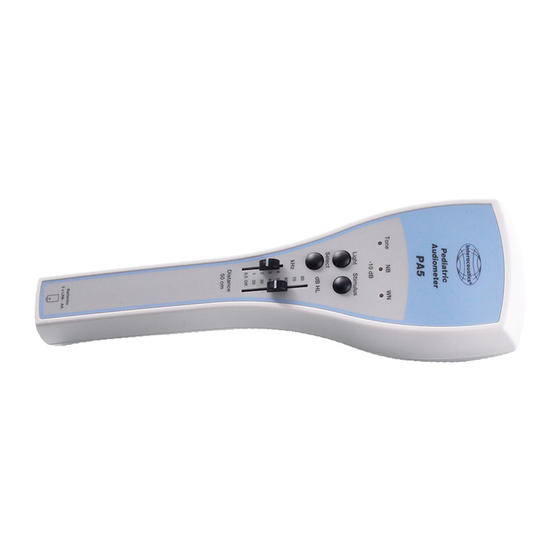
Interacoustics PA5 Instructions For Use Manual
Hide thumbs
Also See for PA5:
- Instructions for use manual (138 pages) ,
- Operation manual (25 pages) ,
- Instructions for use manual (66 pages)
Table of Contents
Advertisement
Quick Links
Advertisement
Table of Contents

Summary of Contents for Interacoustics PA5
- Page 1 Science made smarter Instructions for Use - US...
-
Page 3: Table Of Contents
Description of various tests ....................... 10 Reflex audiometry by Neonates ....................10 Maturation of audiotory response....................11 Maintenance ............................13 How to clean Interacoustics products ..................13 Concerning repair ........................14 Warranty ............................ 14 Technical specifications ........................15 Calibration values ........................16... -
Page 5: Introduction
Intended use The PA5 handheld paediatric screening audiometer is designed to be a device for screening for hearing loss primarily amongst children. Output and specificity of this type of device are based on the test characteristics defined by the user and may vary depending on environmental and operating conditions. The screening for hearing loss using this kind of audiometer depends on the interaction with the patient. - Page 6 Page 2 D-0131335-A – 2021/09 PA5 Instructions for Use - US...
-
Page 7: Unpacking And Installation
Return Report will be of great help to us and is your best guarantee that the correction of the problem will be to your satisfaction. Storage If you need to store the PA5 for a period, please ensure it is stored under the conditions specified in the section for technical specifications: Page 3 D-0131335-A –... -
Page 8: Marking
This symbol indicates that when the end-user wishes to discard this product, it must be sent to separate collection facilities for recovery and recycling. The CE-mark in combination with MD symbol indicates that Interacoustics A/S meets the requirements of the Medical Device Regulation (EU) 2017/745. -
Page 9: Malfunction
In case of death or serious incident in relation to the use of the device, the incident must immediately be reported to Interacoustics and the local national competent authority. Page 5 D-0131335-A –... - Page 10 Page 6 D-0131335-A – 2021/09 PA5 Instructions for Use - US...
-
Page 11: Getting Started - Setup And Installation
20 and 80 dB, HL can be selected in steps of 10 dB when the distance between the ear and the loudspeaker of the PA5 is 50 cm or the PA5 is switched off by leaving the intensity control switch in the “Off”... - Page 12 Battery Description Replacing Batteries: To replace old batteries, unscrew the small black lid in the narrow end of PA5 and the batteries can be taken out. Replace with three new AA batteries. When inserting the new batteries make sure that they are inserted correctly according to the small drawing in the bottom part of the control panel.
-
Page 13: Replacing Batteries
Replacing batteries To replace old batteries, unscrew the small black lid in the narrow end of PA5 and the batteries can be removed. Replace with three new AA batteries. When inserting the new batteries please make sure that they are inserted correctly according to the small drawing in the bottom part of the control panel. -
Page 14: Description Of Various Tests
Other responses than the APR can be arousal from sleep, crying or diminished activity. The COR Test: The Paediatric Audiometer PA5 can perform Conditioned Orientation Audiometry based on a technique described by Suzuki and Ogiba (1961). The phenomenon called “Orientation Reflex” is not a learned response, but a natural reflex movement elicited by sound or visual stimulation. -
Page 15: Maturation Of Audiotory Response
Sound localisation to the side and direct below. MRL: 25-35 dB. Minimum response level, dB HL. The MRL levels are recorded in sound cabins. In noisy surroundings the levels will have to be correspondingly higher. Page 11 D-0131335-A – 2021/09 PA5 Instructions for Use - US... - Page 16 16-21 months of age Direct sound localisation to the side, below, indirect above. MRL: 25-35 dB. 21-24 months of age Locates directly sound at any angle. MRL: 25-30 dB. Page 12 D-0131335-A – 2021/09 PA5 Instructions for Use - US...
-
Page 17: Maintenance
Clean cushions and patient hand switch and other parts with a lint free cloth lightly dampened in • cleaning solution Make sure not to get moisture in the speaker portion of the earphones and similar parts • Page 13 D-0131335-A – 2021/09 PA5 Instructions for Use - US... -
Page 18: Concerning Repair
Interacoustics warrants that: • The PA5 is free from defects in material and workmanship under normal use and service for a period of 12 months from the date of delivery by Interacoustics to the first purchaser Accessories are free from defects in material and workmanship under normal use and service for •... -
Page 19: Technical Specifications
Technical specifications Medical CE- The CE-mark in combination with MD symbol indicates that Interacoustics A/S mark meets the requirements of the Medical Device Regulation (EU) 2017/745. Approval of the quality system is made by TÜV – identification no. 0123. Standards... -
Page 20: Calibration Values
0 dB 1000 2000 -1,5 -1,5 3000 -6,0 -4,0 4000 -6,5 -5,0 Values for Headphone TDH39: Frequency (Hz) ISO 389 (dB re. 20 µPa) 11,5 1000 2000 3000 10,5 4000 Page 16 D-0131335-A – 2021/09 PA5 Instructions for Use - US...















Need help?
Do you have a question about the PA5 and is the answer not in the manual?
Questions and answers